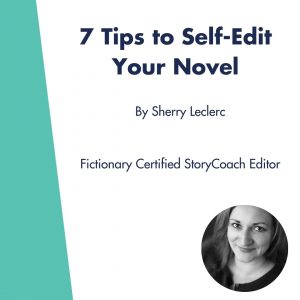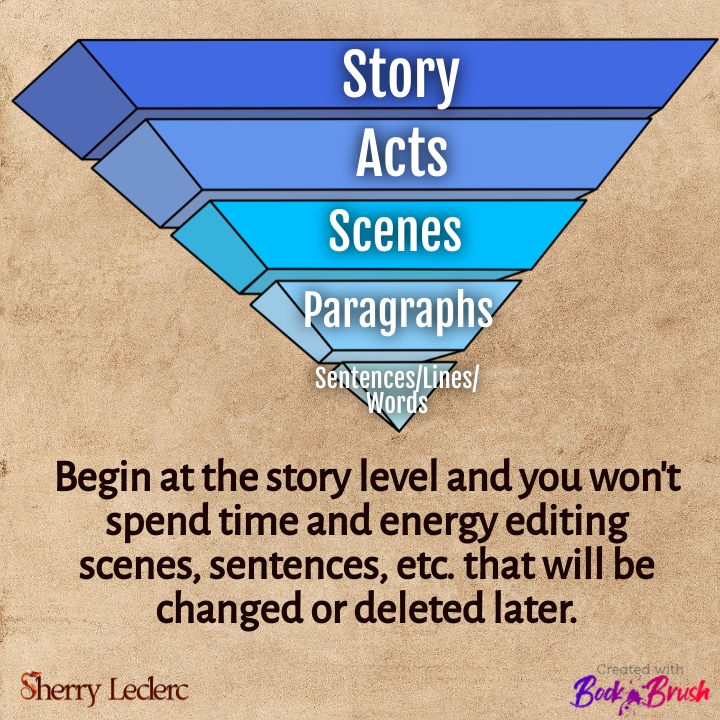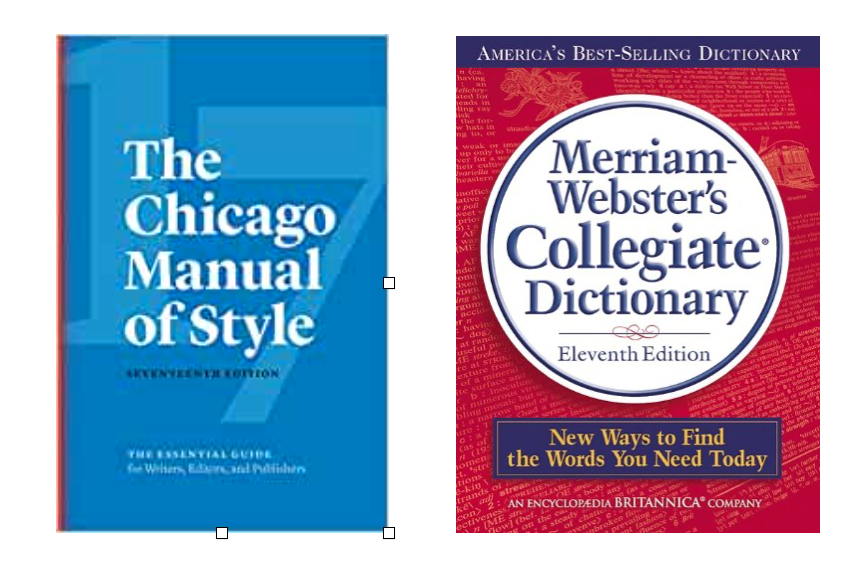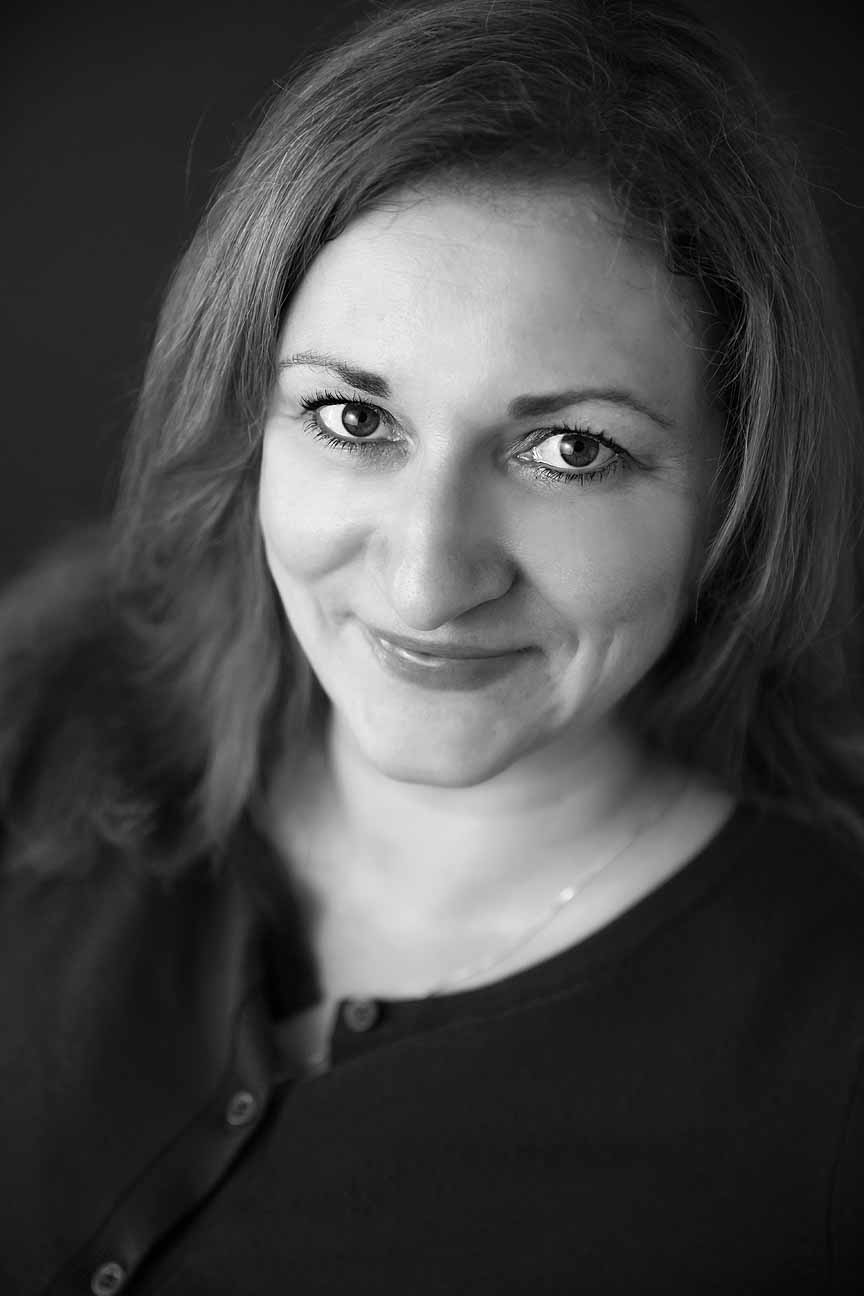
Before we cover 7 Tips to Self-Edit Your Novel, I’d like to introduce Sherry Leclerc. Sherry is enrolled in the 2021 Summer Fictionary Certified StoryCoach program. Sherry is an experienced fiction editor and shares with us her take on self- editing your novel.
So over to Sherry…
![]()
Self-editing is a skill that all novelists need. For self-publishing authors, especially those just starting out, it can be particularly important, because the stronger your story and the cleaner your manuscript when it’s time to pass it on to a professional editor, the less time and money you’ll have to spend on a professional edit.
In this article, I’ll discuss when you should start self-editing your manuscript as well as some tips on how to go about it.
When to Edit:
“Do not edit while you write”
Do NOT edit during the writing process. Writing is a creative, artistic process, whereas editing is very logical. Keep yourself in a creative mindset when you are writing your first draft.
A piece of advice I use and have heard repeated by a number of other authors is to complete your first draft, put it away for a few weeks, a month, or even more, then take it out again to begin editing. This way, the story is not still fresh in your mind and you are more likely to pick up on things you might have otherwise missed.
Tips for Self-editing:
- Self-edit your manuscript before you send it out to beta-readers or professional editors but expect to do more editing once you get their feedback.
- There are different types of editing: story editing (also called developmental or structural editing for fiction), manuscript evaluation, substantive editing, copyediting and proofreading (these terms can change somewhat depending on if you are writing fiction or non-fiction, but in this article I am focusing on fiction).
- Start with the big, story-level things and work your way down (story, then acts, then scenes, then paragraphs and lines).
“Start at the story level”
Visualize it as an upside-down pyramid. Each smaller section fits into the larger section above it. Start with the big-picture because, if you start with the smaller things, you may be wasting time and energy editing things that you will cut out or change once you get to the copy edit.

4. At the story level, think about your genre and the plot structure you are using, as well as the conventions, scenes and tropes that are expected in your genre.
“Understand tropes & conventions, how they work, and why you need them.”
I’m sure many of you have heard people say, “I’m tired of the same old tropes.” But the reality is that if you are missing the important ones, the reader will feel like your story is missing something, even if they can’t consciously say what that is.
The challenge for the writer is to use the old conventions and tropes in new, imaginative ways that the reader may not have seen before.
If you do decide to leave something out, understand that in order to successfully cut out tropes and conventions, you need to know what they are and how they work first.
If you decide to leave them out, have a purpose in doing so.
5. To edit at the story level, you can open a word doc, a google doc, a spreadsheet, or even write on a sheet of paper or in a legal pad. Write down all the necessary parts of a story on one side, then write where these are in your book on the other side. Are you missing anything? If you are, you may need to go back and add it. Better yet, use a tool like Fictionary StoryTeller to keep yourself organized.If you are unsure about what plot points need to be included, what they should look like, and where they should happen (story arc), check out this article on plot structure by Kristina Stanley.
6 After you edit at the story level, look at your book scene by scene. Here are some questions to ask yourself as you’re working through your scenes:
-
-
- Does the scene move your story forward? In other words, is it necessary to your plot or story goal? If not, cut it.
- Does the scene have conflict or tension? Every scene must have conflict, but this doesn’t mean you need to have physical battles in every scene.
- Does the scene turn? What this means, in very basic terms, is if the scene starts out positive, there should be a point where it switches to negative, or negative to positive, positive to very positive, negative to very negative…you get the idea.
-
7. Once you finish looking at the scene level, then you can go down to the paragraph and line level (line-editing or copy-editing).
Tips:
-
-
- Read it out loud to yourself. This will help you notice things such as sentence structure problems, misspelled or misused words, run-on sentences, and so on. It will also tell you if the dialogue seems natural or not.
- At this level, you should be using the standard tools for fiction work. For fiction writing in North America, this is usually the Chicago Manual of Style for grammar and structure questions and The Merriam-Webster Collegiate Dictionary if you are unsure about the spelling of a word.
- Another tool to use is ProWritingAid. You can copyedit within Fictionary StoryTeller.
-
All of these resources have online versions that will give you the most up-to-date information. Don’t just count on your spell-checker, because you may not know what dictionary or standards the spell checker is based on.

-
-
- If the CMS is unclear, or states there are options for a style or grammar point, then the most important thing is to choose one of the correct options to use, then stick to that throughout the whole book. The same applies to when there are different possible spellings of a word.
-
“Consistency is key!”
-
-
- Make a list of these choices on a style sheet so you remember them as you go through the manuscript. You can give this sheet to your professional editor to refer to once you are at that point.
-

Self-editing with Fictionary’s StoryTeller
Though this article is written for the Fictionary blog, it is not in any way a paid advertisement. I was truly excited when I first came across StoryTeller online, especially when I saw everything it could do.
In the past, I used spreadsheets to edit at the story and scene levels (tips 5 and 6 above). I listed out each scene, the word count, the purpose of the scene, the on- and off-screen characters, and so on.
At the end, I had to look at all the information I gathered to map out if I’d hit all the important points in my novel and if they came at the correct places. It was a very useful, but very time-consuming, process.
Then I saw an advertisement for Fictionary’s StoryTeller online writing and self-editing software for authors that helps analyze your manuscript at the story level. I started with the free trial, but very quickly upgraded to a subscription once I realized that it does the same thing my spreadsheets did, but much, much more quickly and efficiently.
As the author, it is up to you to double-check for accuracy, such as if the software chose the correct point of view character for each scene. You should also double-check if the software chose the correct scenes for the inciting incident, plot point 1, midpoint, plot Point 2, climax, and resolution.
Once you have verified these points, you can rest assured that the story arc it has automatically drawn for you is complete and correct. This diagram will show you at a glance if you’ve left out any essential points, and if they hit at the right places in your novel.
My Final Point:
Finally, always remember that self-editing does not replace a professional edit. We self-edit to prepare our manuscript for a professional editor, which will hopefully save the editor time and the author money.
“Self-editing does not replace a professional edit.”
As the author, it is very likely you will miss things in your own work that a fresh set of eyes would not. We know what we meant, so our minds will automatically fill in any missed words, for example. Also, if we cut or changed anything along the way, the information will still be in our memories, so we can miss any conflicting information or plot holes created by these changes.
When you are ready for a professional, story level edit, consider using a Fictionary Certified Story Coach. These editors are professionally trained to use software similar to StoryTeller to objectively analyze your story.
At the end of a StoryCoach edit, your editor will provide you with a detailed report and summary, and you will be provided with a StoryCoach account of your own. All of these things are provided to let you know when you are on track as well as to suggest changes that can help you make your story the best it can be before it is sent off for a copy-edit.
Sherry Leclerc
 An experienced author, editor, and educator, Sherry Leclerc has been teaching English and French to primary through to adult students since 2000. She self-published her first fantasy novel under her own imprint, Ternias Publishing, in 2017 and has since self-published another fantasy novel and a romance novella, which was published under a pen-name.
An experienced author, editor, and educator, Sherry Leclerc has been teaching English and French to primary through to adult students since 2000. She self-published her first fantasy novel under her own imprint, Ternias Publishing, in 2017 and has since self-published another fantasy novel and a romance novella, which was published under a pen-name.
Sherry has published numerous blog articles on her own website and has guest-posted on other sites as well. She has a YouTube vlog titled The Mythic Quill, where she talks about various writing and self-publishing related topics, posts book reviews, and so on.
Sherry is a member of the Canadian Authors Association and Editors Canada. She is a Writer’s Digest Certified Copy-editor and is a Fictionary Certified StoryCoach Editor.
Social Media Links:
Websites:
www.sherryleclerc.com


